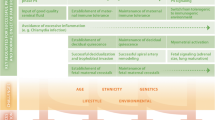Abstract
Objective
To evaluate whether the mode of delivery (vaginal versus C-section) influences the levels of CD4+CD25+FOXP3+ Treg cells in cord blood and maternal peripheral blood and also to examine its relationship with plasma cortisol levels.
Methods
Newborns either born vaginally (n = 19) or via elective C- section (n = 20) and their mothers, as well as 20 healthy but not pregnant women, were included in the study. CD4+CD25+FOXP3 (Treg) cells were examined by flow cytometry. Total lymphocyte counts (TLC) and serum cortisol levels were also determined for all the groups.
Results
The percentages of CD4+CD25+FOXP3 cells and the serum cortisol levels of infants born vaginally (p < 0.004 and p < 0.0001) and their mothers (p < 0.0001 for both) were found to be significantly higher than those of newborns born by C-section and their mothers. Positive correlations were seen between CD4+CD25+FOXP3+ cells (r = 0.741) and serum cortisol levels (r = 0.468). No relationship was observed between newborns delivered by C-section and their mothers (r = 0.022 for both).
Conclusions
This study suggests that mode of delivery affects cord blood Treg cells. Higher CD4+CD25+FOXP3+ Treg cells of newborns and their mothers in vaginal delivery group and their relationship with serum cortisol levels suggest a stress phenomenon related to vaginal delivery.
Similar content being viewed by others
References
Godfrey WR, Spoden DJ, Ge YG, et al. Cord blood CD4+CD25+ derived T regulatory cell lines express FoxP3 protein and manifest potent suppressor function. Blood. 2005;105:750–8.
Takahata Y, Nomura A, Takada H, et al. CD25+CD4+ T cells in human cord blood: an immunoregulatory subset with naive phenotype and specific expression of forkhead box p3 (Foxp3) gene. Exp Hematol. 2004;32:622–9.
Karagiannidis C, Akdis M, Holopainen P, et al. Glucocorticoids upregulate FOXP3 expression and regulatory T cells in asthma. J Allergy CIin Immunol. 2004;114:1425–33.
Vogl SE, Worda C, Egarter C, et al. Mode of delivery is associated with maternal and fetal endocrine stress response. BJOG. 2006;113:441–5.
Kolås T, Saugstad OD, Daltveit AK, Nilsen ST, Qian P. Planned caesarean versus planned vaginal delivery at term: comparison of newborn infant outcomes. Am J Obstet Gynecol. 2006;195:1535–43.
TNSA2003: http://www.hips.hacettepe.edu.tr/tnsa2003/data/turkce/bolum10.pdf
Gessler P, Dahinden C. Increased respiratory burst and increased expression of complement receptor-3 (CD11b/CD18) and of IL-8 receptor-A in neutrophil granulocytes from newborns after vaginal delivery. Biol Neonate. 2003;83:107–12.
Chirico G, Gasparoni A, Ciardelli L, Martinotti L, Rondini G. Leukocyte counts in relation to the method of delivery during the first 5 days of life. Biol Neonate. 1999;75:294–9.
Brown MA, Rad PY, Halonen MJ. Method of birth alters interferon-gamma and interleukin-12 production by cord blood mononuclear cells. Pediatr Allergy Immunol. 2003;14:106–11.
Mears K, Mcauliffe F, Grimmes H, Morrison JJ. Fetal Cortisol in relation to labour, intrapartum events and mode of delivery. J Obstet Gynecol. 2004;24:129–32.
Thilaganathan B, Meher-Homji N, Nicolaides KH. Labor: an immunologically beneficial process for the neonate. Am J Obstet Gynecol. 1994;175:1271–2.
Thornton CA, Capristo CC, Power LL, et al. The effect of labor on neonatal T-cell phenotype and function. Pediatr Res. 2003;54:119–24.
Malamitsi-Puchner A, Protonotariou E, Boutsikou T, Makrakis E, Sarandakou E, Creatsas G. The influence of the mode of delivery on circulating cytokine concentrations in the perinatal period. Early Hum Dev. 2005;81:387–92.
Penders J, Thijs C, Vink C, et al. Factors influencing the composition of the intestinal microbiota in early infancy. Pediatrics. 2006;118:511–21.
Groenlund MM, Nuutila J, Pelto L, et al. Mode of delivery directs the phagocyte functions of infants for the first 6 months of life. Clin Exp Immunol. 1999;116:521–6.
Roncador G, Brown PJ, Maestre L, et al. Analysis of FOXP3 protein expression in human CD4+CD25+ regulatory T cells at the single-cell level. Eur J Immunol. 2005;35:1681–91.
Ikincioğullari A, Kendirli T, Doğu F, et al. Peripheral blood lymphocyte subsets in healthy Turkish children. Turk J Pediatr. 2004;46:125–30.
Bisset LR, Lung TL, Kaelin M, Ludwig E, Dubs RW. Reference values for peripheral blood lymphocyte phenotypes applicable to the healthy adult population in Switzerland. Eur J Haematol. 2004;72:203–12.
Ly NP, Ruiz-Perez B, McLoughlin RM, et al. Characterization of regulatory T cells in urban newborns. Clin Mol Allergy. 2009;7:8.
Kero J, Gissler M, Grönlund M, et al. Mode of delivery and asthma—is there a connection? Pediatr Res. 2002;52:6–11.
Negele K, Heinrich J, Borte M, von Berg A, Schaaf B, Lehman I, et al. Mode of delivery and development of atopic disease during the first 2 years of life. Pediatr Allergy Immunol. 2004;15:48–54.
Schaub B, Liu J, Höppler S, et al. Maternal farm exposure meulates neonatal immune mechanisms through regulatory T cells. J Allergy Clin Immunol. 2009;123:774–82.
Conflict of Interest
None.
Role of Funding Source
Supported by Ankara University Scientific Research Project Department Project no; 2007080904HPD.
Author information
Authors and Affiliations
Corresponding author
Rights and permissions
About this article
Cite this article
Yildiran, A., Yurdakul, E., Guloglu, D. et al. The Effect of Mode of Delivery on T Regulatory (Treg) Cells of Cord Blood. Indian J Pediatr 78, 1234–1238 (2011). https://doi.org/10.1007/s12098-011-0400-6
Received:
Accepted:
Published:
Issue Date:
DOI: https://doi.org/10.1007/s12098-011-0400-6




